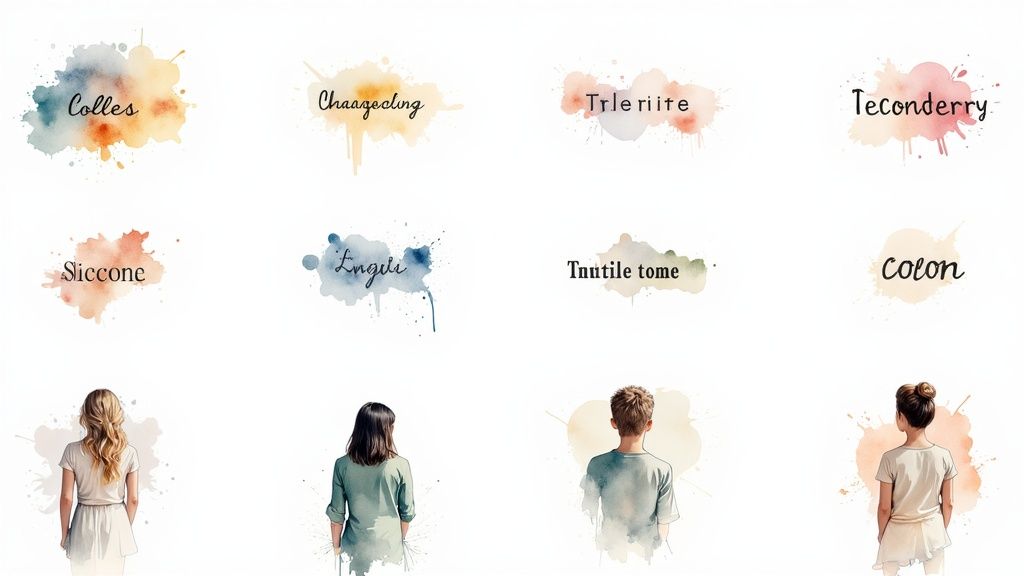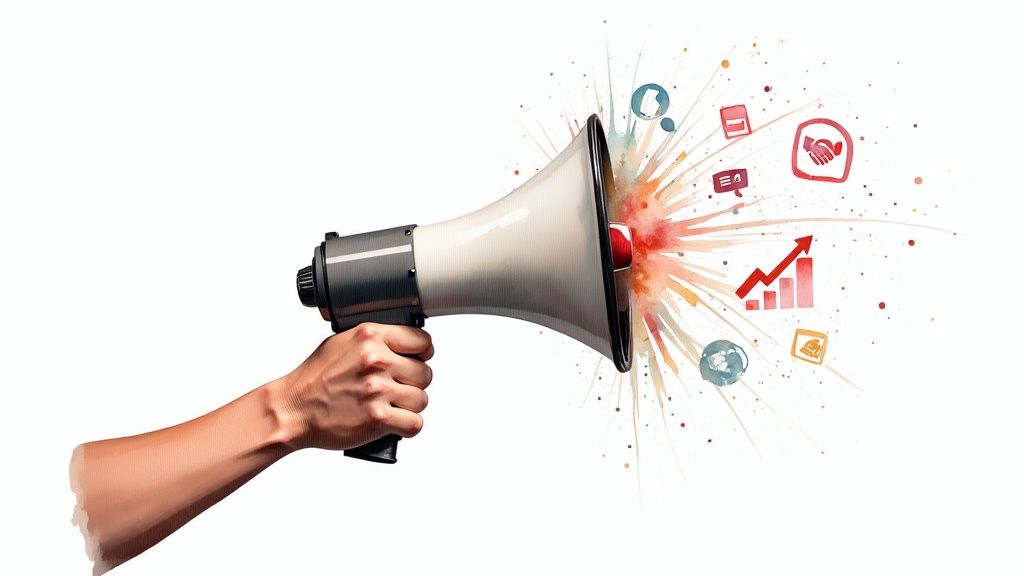You can't build awareness for a brand that doesn't know what it is. Before you even think about tactics like SEO or social media, you need a rock-solid identity.
Think of your brand as a person. What does it stand for? How does it talk? What does it care about? Nailing this down is what makes a brand memorable and cuts through the noise. This isn't just about a cool logo or a catchy tagline; it's the core promise you make to your audience. Every blog post, every tweet, every customer email needs to echo that same story.
Define Your Unique Brand Voice
Your brand voice is the personality that comes through in all your communications. Are you witty and a bit rebellious, like Wendy's on X? Or are you more inspiring and authoritative, like Nike?
A well-defined voice makes you instantly recognizable. It’s what helps you build a real connection instead of just being another company selling stuff.
To find your voice, ask yourself: * If my brand were a person, what three words would describe it? (e.g., helpful, expert, approachable) * What's the main goal of our communication? Is it to educate, entertain, or inspire? * Who is our ideal customer, and what's their communication style like?
Once you have your answer, that voice needs to be everywhere—from your website's homepage to your email signature. Consistency is key.
Pinpoint Your Target Audience
You can't be everything to everyone. It's a classic mistake. Trying to appeal to a massive, generic audience is the fastest way to be ignored.
Instead, zero in on a specific group of people who will genuinely love what you offer. Go deep. Create detailed buyer personas that cover more than just age and location. What keeps them up at night? What are their biggest goals? Where do they hang out online?
Your brand is a meaning-based asset. For it to be powerful, its meaning must be inherently social and resonate deeply with a specific group of people. Getting this right is the difference between shouting into the void and building lasting connections.
When you know exactly who you're talking to, every other marketing decision gets easier. You'll know which social platforms to focus on and what kind of content will actually hit home.
This chart shows how top brands typically split their efforts across major awareness-building channels.

As you can see, it's a balanced game. A strong digital presence through social media and content is non-negotiable, but real-world engagement through events and PR still plays a huge role.
Today's consumers discover brands all over the place. To put some numbers on it, one global survey found that people encounter new brands through an average of 5.8 different channels.
Where are they looking first? Let's break it down.
Top Channels for Brand Discovery
The data below shows the primary channels where consumers first discover a new brand. It highlights a mix of digital and traditional touchpoints.
| Channel | Percentage of Consumers Discovering Brands |
|---|---|
| Search Engines | 32.8% |
| TV Ads | 32.3% |
| Word-of-Mouth Recommendations | 28.8% |
| Ads on Social Media | 27.8% |
| Brand/Product Websites | 26.8% |
What's clear is that you can't just put all your eggs in one basket. While search engines and TV ads lead the pack, word-of-mouth and social media are right behind them, proving that a multi-channel strategy is essential.
If you're thinking about shaking up your own brand identity, it's worth studying how the big players have done it. Digging into iconic rebranding strategies and examples can give you a ton of valuable insight into how a refresh can completely change public perception and boost awareness.
Driving Organic Visibility with Content and SEO

You can have the best content in the world, but if nobody finds it, does it even exist? That's the hard truth. To get seen, your content has to perfectly sync up with what your audience is actually searching for.
This is where search engine optimization (SEO) comes in. Think of it as the bridge between what you want to say and what your audience needs to hear. Get this right, and you turn your website into a magnet for organic traffic.
Uncovering Audience Needs with Keyword Research
Good SEO isn't about jamming keywords onto a page. It's about a bit of digital detective work. You’re uncovering the real problems, questions, and pain points your ideal customers are typing into Google every single day.
Start by brainstorming some broad topics connected to your business. If you sell project management software, you might think of "team collaboration" or "project planning." Simple enough.
But then you dig deeper. Using SEO tools, you can find the specific, long-tail phrases that show what people are really after. Instead of the generic "project management," you'll find gold nuggets like:
- "how to manage a remote development team"
- "best tools for small business project tracking"
- "project timeline template for marketing campaigns"
These aren't just keywords; they're direct requests for help. When you create content that answers these queries, you’re not just a brand—you’re a problem-solver.
Building Authority with Topic Clusters
Once you know what people are looking for, you need to show Google you're the expert on the subject. One of the most effective ways I've found to do this is by building topic clusters.
Here's the concept: You create a massive, in-depth "pillar page" on a broad topic. Then, you surround it with several shorter "cluster" posts that dive into related subtopics, all linking back to that main pillar.
For example, your pillar page could be a huge guide on "Content Marketing Strategy." From there, you'd link out to cluster posts like:
- "Creating a Content Calendar"
- "Writing SEO-Friendly Blog Posts"
- "Measuring Content ROI"
This structure does two things brilliantly. It tells search engines you have deep, comprehensive knowledge in that area, which boosts your authority. It also creates a content ecosystem that keeps users clicking and exploring your site.
Building a library of valuable content is a long-term play. It’s not about one viral hit; it's about consistently showing up with the answers your audience needs, establishing trust one search query at a time.
On-Page SEO Essentials for Visibility
Even the most amazing content needs a little help to get noticed by search engines. On-page SEO is all about tweaking your individual pages so they're crystal clear to both Google's bots and human readers.
Here are the non-negotiables for every piece of content you publish:
- A compelling title tag: This is your headline in the search results. It has to include your main keyword and be interesting enough to make someone click.
- A clear meta description: This is the short summary that appears under the title. Think of it as a mini-ad for your page—summarize the value and tell them what to do next.
- Well-structured headings (H1, H2, H3): Headings break up your content and make it scannable. Use them to create a logical flow, and sprinkle in your keywords where they feel natural.
- Internal links: Always link to other relevant pages on your own site. This helps search engines find more of your content and keeps visitors engaged longer. For more ideas on creating content that drives growth, check out the various strategies discussed on the Rebel Growth blog.
Building Community Through Social Media Engagement
 Too many brands treat social media like a digital billboard. They shout their message into the void and wonder why no one’s listening. But social media isn’t a one-way street; it’s a living, breathing space where you can build a real following.
Too many brands treat social media like a digital billboard. They shout their message into the void and wonder why no one’s listening. But social media isn’t a one-way street; it’s a living, breathing space where you can build a real following.
The goal isn't just to rack up passive followers. It's to turn them into passionate advocates for your brand. That shift happens when you stop broadcasting and start sparking genuine conversations. It's about creating a sense of belonging, which starts by showing up where your audience actually hangs out.
Choosing the Right Platforms
Don't fall into the trap of trying to be everywhere at once. It’s a surefire way to burn out and get mediocre results across the board. The key is to be strategic.
If your brand is highly visual—think fashion, food, or travel—platforms like Instagram and TikTok are your natural home. They’re built for compelling images and short-form video. For B2B companies, on the other hand, LinkedIn is the place to be. It provides the perfect professional backdrop for sharing industry insights and networking with peers.
To make an informed choice, you need to understand your audience's habits. Where are they already talking about your industry? Social listening tools can give you a clear answer, removing the guesswork. You can find a whole suite of them in this digital marketing directory. This data-driven approach means you’re investing your energy where it will actually make a difference.
Creating Shareable and Interactive Content
Once you've zeroed in on the right platforms, it's all about the content. And I don’t mean just another static post. To get real traction, you need to create stuff that people genuinely want to interact with and share.
Interactive content is what cuts through the noise and gets people talking. Here are a few ideas I've seen work time and time again: * Interactive Polls and Quizzes: These are incredibly simple but effective. Ask your audience for their opinion on a new product feature or create a lighthearted quiz related to your niche. It’s an easy way to make followers feel like their voice matters. * User-Generated Content (UGC) Campaigns: Get your customers involved. Encourage them to share photos or videos of themselves using your product and tag it with a unique hashtag. When you repost their content, it serves as powerful, authentic social proof. * Behind-the-Scenes Stories: People connect with people, not logos. Show them the human side of your brand. Share quick videos of your team working on a project, the messy-but-real process of creating a product, or even a funny moment from around the office.
The most successful social media strategies treat the platform like a two-way conversation. It's not about what you can sell; it's about the value and connection you can build. When you put community first, awareness naturally follows.
Engaging in Niche Communities
Sometimes, the most valuable conversations aren't happening on your own page. They're tucked away in smaller, highly dedicated online communities. Think specific subreddits, focused Facebook Groups, or industry forums.
The key to engaging here is to leave your sales pitch at the door. Your goal is to be genuinely helpful. Jump into discussions, answer questions, and offer your expert advice freely. When you establish yourself as a trusted resource, you build an incredible reputation and authentic relationships.
This approach shows you care about the community and its interests, not just your own bottom line. That's how you foster the kind of deep loyalty that fuels powerful word-of-mouth marketing.
Accelerate Growth with Strategic Partnerships

Trying to build a brand all by yourself is a grind. One of the absolute fastest ways to get your name out there is to tap into an audience that already loves and trusts another business. It’s like getting a personal recommendation from a good friend.
Strategic partnerships let you borrow that credibility and get exposure you simply couldn’t achieve on your own, at least not quickly. When a brand your target audience already follows gives you a nod, that trust gets transferred to you. It’s a powerful head start.
Finding and Vetting the Right Partners
So, where do you start? The search begins with one simple question: Who’s already talking to my ideal customers in a non-competitive way?
If you sell high-end, single-origin coffee beans, a company making premium espresso machines is a no-brainer. Their customers are your customers. Start making a list of these complementary businesses.
As you build your list, look for companies that have a similar audience size and engagement level. The goal is a peer-to-peer collaboration, not a tiny brand begging a huge corporation for a shout-out. That rarely works.
Before you reach out, you need to do your homework. Analyze their:
- Audience Engagement: Are people actually commenting on and sharing their posts? High engagement is a sign of a loyal, dialed-in audience.
- Brand Values: Dig into their mission and how they communicate. A mismatch in values can do more harm than good to your reputation.
- Content Quality: Is their stuff well-produced and genuinely helpful? Associating your brand with sloppy, low-quality content will only drag you down.
Once you’ve got a solid shortlist, it's time to craft a pitch that’s all about mutual benefit. Don't just ask for something. Frame your proposal around what they get out of it—whether that's fresh content for their audience, access to your unique expertise, or co-branded exposure.
Structuring a Win-Win Collaboration
A successful partnership needs a clear game plan. Vague agreements just lead to confusion and mediocre results. You need to sit down and define exactly what success looks like for both of you before you kick things off.
The best partnerships are built on a bedrock of shared value. When both brands stand to gain something real—whether it's leads, exposure, or a credibility boost—the entire collaboration is energized and far more likely to crush it.
Here are a few proven models for collaborations that seriously boost brand awareness:
Collaboration Models and Their Benefits
| Collaboration Model | Primary Benefit for Your Brand | Example Scenario |
|---|---|---|
| Co-Hosted Webinars | Access a new email list and position yourself as an expert. | A financial planning app teams up with a real estate investment blog to host a webinar on "First-Time Home Buying." |
| Guest Blogging | Score high-quality backlinks and get in front of an established readership. | A cybersecurity software firm writes a guest post for a major tech publication on how small businesses can dodge phishing scams. |
| Influencer Marketing | Get authentic social proof and reach a niche, dedicated following. | A sustainable fashion brand works with an eco-conscious lifestyle influencer to show off their new clothing line. |
Each of these approaches gives you a unique lane to put your brand in front of a fresh, highly relevant audience. By picking the right partners and being thoughtful about how you structure the deal, you can build a powerful engine for brand awareness that accelerates your growth.
Measuring Your Brand Awareness Effectively
If you can't measure it, you can't improve it. That old saying is especially true when it comes to brand awareness. Launching slick, creative campaigns is the fun part, but if you don't have a clear way to track what’s actually working, you're just throwing money into the wind.
Forget vanity metrics like a handful of social media likes. We're talking about tangible indicators that prove your brand's footprint is genuinely growing. This isn't about getting bogged down in complex algorithms, either. It’s about knowing which data points to watch, what they mean, and how to use them to show a real ROI on your efforts.
Tracking Your Digital Footprint
The most straightforward way to see if your brand is becoming more memorable is to look at how people are finding you online. There are two key metrics that are your best friends here: direct traffic and branded search.
- Direct Traffic: This is the gold standard. It means someone knew your brand well enough to type your URL directly into their browser. An upward trend in direct traffic is a powerful signal that people know you by name.
- Branded Search Traffic: This tracks how many people are specifically searching for your company or product names in Google. You can easily monitor this using Google Search Console. When you see an increase here, it means people are actively looking for you, not just a generic solution.
When you see both of these metrics climbing together, that's your sign. It means your efforts are paying off and your brand is becoming a destination, not just a random stop people stumble upon.
The economic impact of a strong brand is impossible to ignore. Just look at the world’s most valuable brands, whose total value recently hit a staggering $10.7 trillion. Apple alone boasts a brand value of $1.3 trillion, a 28% jump in just one year. These aren't just abstract numbers; they show that building brand awareness directly translates into massive financial growth. You can dig into these valuations in Kantar's global report.
Analyzing Social and Media Mentions
Beyond your own website, you need to understand what the conversation about your brand looks like out in the wild. This is where media monitoring tools are indispensable. They act as your eyes and ears, catching every mention of your brand across social media, blogs, news sites, and forums.
This gives you a clear picture of your Share of Voice (SoV)—basically, how much of the conversation in your industry is about you versus your competitors. If your SoV is on the rise, you’re successfully capturing more of your audience’s attention.
These tools also help you track sentiment. Are people saying good, bad, or neutral things about you? Context is everything. A huge spike in traffic might look great on paper, but a monitoring tool can tell you if that attention is for the right reasons. When you combine this qualitative data with hard numbers from sources like your campaign-specific landing pages, you get a complete, actionable view of your brand’s health.
Common Questions About Improving Brand Awareness
As you start mapping out your plan to boost brand awareness, a few key questions almost always pop up. Getting the hang of the subtle differences between concepts and setting realistic goals is a huge part of long-term success. Let's tackle some of the most common hurdles right now.
The first step is simply understanding the lingo.
Brand Awareness vs. Brand Recognition
A lot of people throw these terms around like they're the same thing, but they actually represent two totally different levels of how familiar a customer is with your brand. Think of it as the difference between someone you just met at a party and a close friend you'd call for help.
Brand recognition is that initial handshake. It’s when someone can spot your brand from a visual cue—a logo, a specific color, or your product's packaging. Seeing the Nike swoosh and immediately knowing what it is? That's classic brand recognition.
Brand awareness, on the other hand, is a much deeper bond. This is when your brand pops into a customer's head when they have a problem to solve or a need to fill, even without seeing your logo. If someone thinks "top-tier athletic gear" and "just do it mentality," and Nike is the first name that comes to mind, that's the holy grail of brand awareness.
How Long It Takes To Build Awareness
Look, building real, meaningful brand awareness is a marathon, not a sprint. Sure, a killer campaign might give you a nice little bump in your metrics in a few months, but getting that top-of-mind status is a long-term game.
For most businesses, you're looking at 12 to 24 months of consistent, multi-channel effort to really cement your brand in your audience's mind. Patience isn't just a virtue here; it's a requirement. The brands that win are the ones that show up, day in and day out, building a little more trust with every single interaction.
Trust is everything. It's the bedrock of brand awareness and has a massive impact on whether someone will buy from you. In fact, studies show that 81% of consumers need to trust a brand before they even think about making a purchase. You build that trust through transparency, consistency, and showing you genuinely care about your audience. You can dig into more stats on how brand trust influences buying decisions at bostonbrandmedia.com.
Cost-Effective Ways to Boost Your Brand
Getting your name out there doesn't have to mean emptying your bank account. Some of the most effective strategies are built on creativity and consistent hustle, not a gigantic ad budget.
Here are a few of my favorite budget-friendly tactics: * Create genuinely helpful SEO content. Find out what your audience is desperately Googling and give them the best answer, period. * Show up in niche communities. Go where your people are. Engage authentically in specific subreddits, focused Facebook groups, or other online forums. Don't sell, just help. * Spark some user-generated content (UGC). Create a fun, branded hashtag and make your customers the stars of the show by featuring their posts. * Team up with micro-influencers. These folks might have smaller followings, but their audience is often incredibly engaged and trusts their recommendations implicitly.
These aren't just cheap marketing tricks; they're powerful ways to build a real community and generate the kind of organic, word-of-mouth buzz that money could never buy.
Ready to take your brand to the next level? rebelgrowth gives you an all-in-one platform to boost your organic traffic, automate your social media presence, and build a brand that gets noticed. Stop guessing and start growing with our powerful AI-driven marketing tools. Explore what rebelgrowth can do for you.
